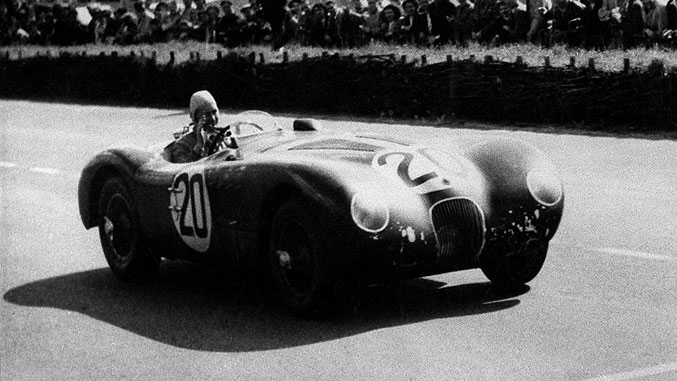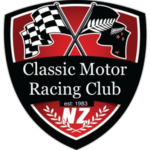Following the last newsletter Ray Deaker passed onto the snoop a video link to a mountain run demonstration of “Fangio’s C Type”. Good viewing it is too. These cars were made for fun. Google “sideways in Fangio’s C type on a wet mountain road” to join that fun. But there is more to the story. No C type shows up on Fangio’s race records, nor does he mention one in his autobiography. So following my own advice on not to trust any guff from an auction website (think Peter Snell’s singlet on this one) a little more digging was in order. It turns out that this was Fangio’s C type, but not for long. But he may never even have known that he “owned” it.
Le Mans began as a race for production sports cars. In 1951 you had to show a production run of at least 10 cars to be eligible for entry. But once past that hurdle you could also enter “prototypes” of cars intended for future production. That is why the C Type was described as XK 120C, a competition version of the production XK 120. After their 1951 victory Jaguar decided on a 10 car production run for the C Type, but the rules changed for 1952 with 50 cars becoming the new production threshold. So a few more C types were added to the line. The car in the mountain video is number 18 off the line. It was delivered to the Belgian Jaguar agents in October 1952.
In early June 1952 Fangio had crashed heavily at Monza and was out of action for the rest of the year. It is hard to run your businesses from a hospital bed while wearing a full neck cast. It was not until early September that the neck brace was removed, and he did not race again until January 1953. Now we enter a grey area. Having announced the 50 car production run Jaguar was inundated with orders. No first in first served here, with many more orders than could be filled a little prioritising was in order. Name drivers and established race teams got priority.

Some wriggling occurred as desperate wannabe’s were quite happy to pay over the odds. The nominal owner would move the car on and pocket a handy profit. Easy enough to do in most places but very difficult to pull off in Argentina in 1952. The importation of complete cars into Argentina was prohibited from 1948 onwards, (local agencies being reduced to being parts departments until they could arrange either local assembly or local manufacture). But if you knew someone in a position to issue an exemption you could get one. It helped if you were not seeking an exemption for a road car.
The photo above shows XKC 018 as advertised for auction in 2001. The auction notes suggest that Fangio may have found a way through this swamp, but even so it is a strange thing to be done by a man renowned for straight dealing. What is known is that XKC 018 was purchased in his name and shipped out of Belgium to the Argentine Jaguar agency before finding its way to a new owner. But Fangio may not have known about it, let alone sat in it. His manager, Marcello Giambertone, states in the Fangio autobiography “My Twenty Years Of Racing” In all those years I only saw him lose his temper once, when he found someone taking advantage of his trust in those close to him to cheat him shamefully.
The auction papers tell us that XKC 018 was found in South America in the late 1980’s, still in its original condition, (twin SU’s carburetors, drum brakes all round, and the early production rear suspension arrangement). At that time it was thought to be the only surviving early C type that had never been upgraded to later specs. Hence perhaps the hefty auction expectations.

Backstory: The original C Type rear suspension was an unusual three link arrangement. Two bottom radius arms on the live axle were connected to a centre clamped transverse torsion bar. A single “A” shaped torque arm was provided over the right rear of the axle. A live axle tends to wind up when power is applied, lifting the right wheel and, with an unlocked diff, giving lots of wheelspin. The torque reaction A arm was inclined downwards so the forces that tended to lift the wheel also induced a tensile force in the arm that pulled the wheel back down. Problem more or less solved.
However side loads on the A arm were high and breakages were not uncommon. The fix for the later cars was to revert to a normal torque reaction link and add a panhard rod to do the sideways location duties. This was shaped in an “S” bend to clear the spare wheel, stowed low on the left hand side. (The engineer in me rebels at the loss of stiffness and extra weight doing things this way. But the proof of any pudding is in its eating).

The production car rule change ended up winning the 1956 Le Mans for Jaguar. The later D type was productionised by a run of 67 body/chassis units. The horrendous crash of 1955 resulted in a ban on the big engined thinly disguised race car “prototypes” that had run up to that year. For 1956 “prototypes” were limited to 2.5 litres, but “production” cars faced no limit. The 3.4 litre D Types, being being the biggest engined cars there that year were gifted the win before the race began.
Finally while the C type was a competition development of the road going XK 120, the D type headed in the other direction. The last few body/chassis units were reverse engineered as real road going cars, the XKSS. 16 examples were made before a fire destroyed the production line (their magnesium body skins burned quite nicely). The remaining ones are both rare and gorgeous. If you find one please send it to me.Footnote: This scribe was fortunate enough to work in South America in the late 80s. The effects of the 1940s local content rules were still visible in their vehicle fleet. (For instance Hillman Avengers badged as Renaults, and 1962 spec Falcons still coming out of the Ford factory doors).
